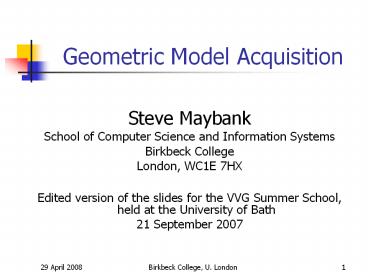Geometric Model Acquisition - PowerPoint PPT Presentation
Title:
Geometric Model Acquisition
Description:
Aim: make a 3D model of a scene from two or more images taken from different viewpoints. ... Origin (0,0,0) at the pin hole. Focal length of the camera = f. ... – PowerPoint PPT presentation
Number of Views:50
Avg rating:3.0/5.0
Title: Geometric Model Acquisition
1
Geometric Model Acquisition
- Steve Maybank
- School of Computer Science and Information
Systems - Birkbeck College
- London, WC1E 7HX
- Edited version of the slides for the VVG Summer
School, held at the University of Bath - 21 September 2007
2
Geometric Model Acquisition
- Aim make a 3D model of a scene from two or more
images taken from different viewpoints. - Why is it possible the image differences depend
in part on the shapes of the objects in the
scene.
3
Two Images of the Same Scene
http//vasc.ri.cmu.edu/idb/images/stereo/fruit SOU
RCE "University of Illinois, Bill
Hoff DESCRIPTION "Fruit on table, digitized from
35mm."
4
Two Images of a Point in R3
Image 1
c1
optical centre
q1
object point
p
q2
optical centre
Epipolar plane ltc1,c2,xgt
c2
Image 2
5
Corresponding Points
- Points in different images correspond,
if they are projections of the same scene
point p. In projective coordinates, projection is
a matrix application,
6
Method for Finding Corresponding Points
7
Example 1 of Correlation Based Matching
Points in lh image (150,100), (250,150),
(350,250), (450,350), (250,450) Correlations (?)
0.750, 0.685, 0.912,
0.644, 0.691 Search area
(2d1)x(2d1) box, d20.
8
What Do We Need for GAM?
- Description of image formation in the camera.
- Description of the relative positions of the
cameras. - Equations involving the measurements, the scene
points and the relative positions of the cameras. - Statistical description of the errors in the
measurements.
9
Pinhole Camera
Small hole (optical centre)
Viewing screen (image)
Object
Light rays
Light tight box
Central perspective projection model for
image formation (Brunelleschi, 15th C.).
10
Camera Coordinate Frame
y
Y
X
x
Z
(0,0,-f)
(0,0,0)
(X,Y,Z)
Origin (0,0,0) at the pin hole. Focal length of
the camera f. Axes of image coordinate frame
are parallel to X, Y axes of the CCF. Image
point (-Xf/Z, -Yf/Z)
11
Mathematical Version of the Camera Coordinate
Frame
Y
y
Image plane
x
X
(0,0,f)
Z
(0,0,0)
(X,Y,Z)
Origin (0,0,0) at the pin hole. Focal length of
the camera f. The image is in front of the pin
hole! Image point (Xf/Z, Yf/Z). The minus signs
have gone.
12
Relative Position of the Cameras
R, t
The relative position of the cameras is
described by an orthogonal matrix R and a
translation vector t.
13
Transformation of Coordinates
? p
R, t
If a point p has coordinates (X,Y,Z)T in the
first CCF, then in the second CCF the same point
p has coordinates
14
Properties of Orthogonal Matrices
15
Projection Ray
Y
?
X
Z
CCF
Any scene point projecting to (x, y, f)T is on
the projection ray.
16
Projection Rays of Corresponding Points 1
?
The projection rays of corresponding points
intersect at a scene point. Geometric model
acquisition is based on this single constraint.
For an extreme example, see http//www.wisdom.wei
zmann.ac.il/vision/VideoAnalysis/Demos/Traj2Traj/
hall.htm
17
Projection Rays of Corresponding Points 2
?
The equations of the projection rays are known,
but they hold in different coordinate systems.
18
Transformation of Coordinates
19
The Essential Matrix
20
Model Acquisition
21
Naïve Estimates of E
22
Better Way of Estimating E
23
Geometric Picture
?
?
First image
Second image
24
Camera Calibration
Ideal pixel coordinates
Measured pixel coordinates
Ideal CCF
Camera calibration is a transformation from
measured pixel coordinates to ideal pixel
coordinates.
25
Calibration Matrix
26
Fundamental Matrix
The fundamental matrix F is defined by
27
Properties of E and F
- det(E)det(Tt)det(R)0
- The matrix E is essential iff SingularValues(E)
(s,s,0) - det(F)det(K)det(E)det(K)0
- The matrix F is fundamental iff
- det(F)0.
28
Minimal Data
29
Books
- D.A. Forsyth and J. Ponce. Computer Vision a
modern approach. Prentice Hall, 2003. - R.C. Gonzalez and R.E. Woods. Digital Image
Processing. Second edition, Prentice Hall, 2002.































